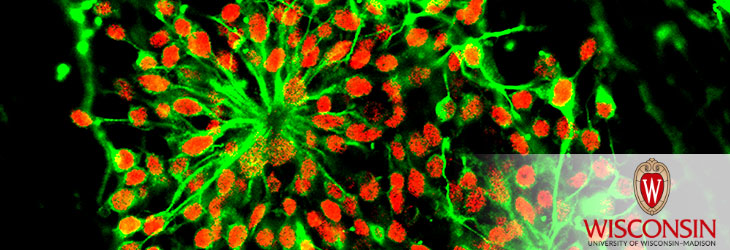Pluripotent Stem Cells

Generating Arterial Endothelial Cell-Seeded Vascular Grafts
WARF: P180255US02
Inventors: James Thomson, Jue Zhang, John Maufort
The Wisconsin Alumni Research Foundation (WARF) is seeking commercial partners interested in methods for generating human arterial endothelial cell-seeded vascular grafts that are capable of replacing or bypassing natural blood vessels and exhibiting increased long-term patency rates and reduced leukocyte adhesion.
Overview
A frequent procedure in cardiovascular surgery is to replace or bypass a blood vessel in order to provide a more adequate flow of blood to downstream tissues. In operations that bypass coronary arteries or peripheral arteries, patients' own veins are often also used as grafts in spite of their long-term relatively high rate of occlusion because the patient lacks suitable additional arterial grafts. To avoid the additional surgeries to harvest and preparation of patients' own veins as grafts, vascular grafts made from synthetic materials, such as expanded polytetrafluoroethylene (ePTFE) are also used, which generally work well for treatments involving the largest diameter vessels but fail in smaller arterials (~3-5 mm diameter) due to high occlusion rate. Lining an ePTFE graft with a patient's own venous endothelial cells improves long-term patency rates of ePTFE grafts in peripheral arterial disease to approximately equal the long term patency rates of venous grafts. However, the entire procedure from vein harvest to transplant takes about a month. Thus, the procedure is expensive, and about 1/3 of the patients with peripheral artery disease have an acute need that cannot wait for this procedure. And because of immune rejection, this approach can only treat an individual patient and cannot be scaled up for the treatment of multiple patients. Finally, although the improvement in patency rates of venous endothelial cell- lined ePTFE grafts over standard ePTFE grafts is quite impressive, those rates still only approach the long-term patency rates of vein grafts, not arterial grafts.
Arterial endothelial cells have distinct physiological properties that make them more suitable than venous endothelial cells for lining synthetic arterial grafts and improving long-term patency rates. However, because of lack of availability, no one to date has been able to use them for that purpose clinically. Accordingly, there remains a need for improved polymeric vascular grafts comprising arterial endothelial cells that are scalable, available as on-demand products, and suitable for multiple patients.
The Invention
UW-Madison researchers James Thomson and Jue Zhang have shown that they can attach the arterial endothelial cells to an ePTFE vascular graft using either fibrin glue or a dopamine coating. (Both methods work, but the dopamine method is simpler and more scalable.) The vascular graft exhibits one or more of (a) reduced thrombosis, (b) increased long-term patency, and (c) reduced platelet adherence, relative to a polymeric substrate not coated with human arterial endothelial cells. They have shown that arterial endothelial cells used to seed the ePTFE can be induced from human pluripotent stem cells, which provide a potentially limitless source for AEC and can be modified to be non-immunogenic to a recipient of the vascular graft.
They have also shown that glycerol is not suitable for freezing SE-ePTFE, but 10 percent DMSO works, used with xeno-free E5 medium. Supplemented with FGF2, VEGFA, SB431542, reserveratol and insulin. Finally, they recently showed that degassing of the ePTFE grafts was important for cell adhesion and expression of CD31, an endothelial cell marker.
Applications
- This hybrid arterial endothelial cell-synthetic vascular graft is capable of replacing or bypassing natural blood vessels for bypass operations in the heart or leg, for reconstructive surgeries to correct developmental abnormalities or to repair severe injuries, or to provide hemodialysis access in arterial-venous shunts etc.
- For patients without an acute need, induced pluripotent stem cells can derived from the patient to produce patient-specific arterial endothelial cells.
Key Benefits
- The arterial cells to seed the ePTFE graft are produced from human pluripotent stem cells, allowing the grafts to be provided to patients as soon as they are needed, and eliminating the need for a second surgery to harvest a vascular graft.
- Arterial endothelial cells seeded on the ePTFE exhibit improved long term patency.
- Arterial endothelialized ePTFE demonstrated low leukocyte adhesion, indicating the resistance to atherosclerosis
- Surface modification of ePTFE via dopamine coating improves cell density and reduced cell death; in addition, de-gas of ePTFE prevents cell aggregate formation and improve cell density.
- Arterial endothelialized ePTFE can be stored in liquid nitrogen.
Stage of Development
The researchers have demonstrated that they can endothelialize an ePTFE graft with arterial endothelial cells using either fibrin glue or dopamine. They have shown that degassing is an important step, and found that these grafts show reduced leukocyte adhesion. Future work will include animal studies and inclusion of vascular smooth muscle cells into the grafts.
Additional Information
For More Information About the Inventors
For current licensing status, please contact Andy DeTienne at [javascript protected email address] or 608-960-9857